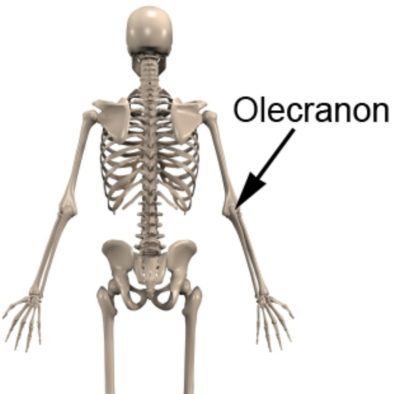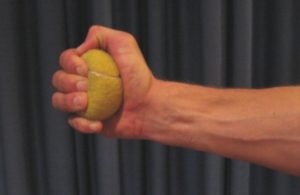Olecranon Fracture
Updated:
What is an olecranon fracture?
An olecranon fracture is a relatively uncommon condition characterized by a break in the bony prominence situated at the back of the elbow known as the olecranon (figure 1).

Figure 1 – Olecranon Fracture Anatomy
The forearm comprises of 2 long bones, known as the radius and the ulna, which are situated beside each other (figure 2). The ulna bone lies on the inner aspect of the forearm and forms joints with the humerus (upper arm bone) (at the elbow), the radius (near the elbow and wrist) and several small carpal bones in the wrist (figure 2). The bony prominence of the ulna situated at the back of the elbow is known as the olecranon (figure 1).

Figure 2 – Relevant Anatomy of the Upper Limb
During certain activities such as a direct impact to the back of the elbow, or a fall onto an outstretched hand, stress is placed on the olecranon. When this stress is traumatic and beyond what the bone can withstand a break in the olecranon may occur. This condition is known as an olecranon fracture.
Sometimes a fracture to the olecranon occurs in combination with other injuries such as a triceps strain or tear, a sprained or dislocated wrist or elbow, a fractured radius (Colles’ fracture), or other fractures of the hand, wrist or forearm (such as following trauma).
Olecranon fractures can vary in location, severity and type including avulsion fracture, stress fracture, displaced fracture, un-displaced fracture, greenstick, comminuted etc.
Causes of an olecranon fracture
An olecranon fracture most commonly occurs due to a direct impact to the point of the elbow or a fall onto the outstretched hand. Olecranon fractures may also occur from a forceful triceps contraction against a fixed ulna. Olecranon fractures are relatively common in sports whereby a fall onto a hard surface is common and unforgiving such as snowboarding, skateboarding, ice skating, cycling, running and jumping sports involving change of direction such as football, soccer, rugby, basketball and netball.
Signs and symptoms of an olecranon fracture
Patients with an olecranon fracture typically experience a sudden onset of sharp, intense elbow, pain at the time of injury. This often causes the patient to cradle the affected arm so as to protect the injury. Pain is usually felt at the back of the elbow and can occasionally settle quickly leaving patients with an ache at the site of injury that is particularly prominent at night or first thing in the morning. Patients with an olecranon fracture may also experience swelling, bruising and pain on firmly touching the affected region of the bone. Pain may also increase during certain movements of the elbow, wrist or shoulder or during weight-bearing activity (such as pushing) through the affected arm. Usually there is pain with either stretching or contracting the triceps muscle as well as an inability to straighten the elbow joint due to pain. Occasionally, pins and needles or numbness may be present in the elbow, forearm, hand or fingers. In severe olecranon fractures (with bony displacement), an obvious deformity may be detected.
Diagnosis of an olecranon fracture
A thorough subjective and objective examination from a physiotherapist or doctor is essential to assist with diagnosis of an olecranon fracture. An X-ray is required to confirm diagnosis. Further investigations such as an MRI, CT scan or bone scan may be required, in some cases, to assist with diagnosis and assess the severity of injury.
Treatment for an olecranon fracture
For those olecranon fractures that are displaced, treatment typically involves anatomical reduction (i.e. re-alignment of the fracture by careful manipulation under anesthetic) followed by surgical internal fixation to stabilize the fracture (using tension band wiring). Early movement exercises are usually started within 1 week of surgery.
For those isolated olecranon fractures that are not displaced treatment typically involves immobilization of the arm in a posterior splint for approximately 2 – 3 weeks. This is usually followed by the use of a removable splint and early range of movement exercises.
Evaluation of the fracture with follow up X-rays is important to ensure the fracture is healing in an ideal position. Once healing is confirmed and the treating surgeon has indicated it is safe to do so, rehabilitation can begin as guided by the treating physiotherapist.
One of the most important components of rehabilitation following an olecranon fracture is that the patient rests sufficiently from any activity that increases their pain. Activities which place large amounts of stress through the olecranon should also be avoided particularly lifting, weight bearing, pushing activities or leaning on the back of the elbow. Rest from aggravating activities allows the healing process to take place in the absence of further damage. Once the patient can perform these activities pain free, a gradual return to these activities is indicated provided there is no increase in symptoms. This should take place over a period of weeks to months with direction from the treating physiotherapist.
Ignoring symptoms or adopting a ‘no pain, no gain’ attitude is likely to cause further damage and may slow healing or prevent healing of the olecranon fracture altogether.
Patients with a fractured olecranon should perform pain-free flexibility and strengthening exercises as part of their rehabilitation to ensure an optimal outcome. This is particularly important, as soft tissue flexibility and strength are quickly lost with immobilization and disuse. The treating physiotherapist can advise which exercises are most appropriate for the patient and when they should be commenced.
Prognosis of an olecranon fracture
Patients with a fractured olecranon usually make a full recovery with appropriate management (whether surgical or conservative). Return to activity or sport can usually take place in weeks to months and should be guided by the treating physiotherapist and specialist. In patients with severe injuries involving damage to other bones, soft tissue, nerves or blood vessels, recovery time may be significantly prolonged.
Physiotherapy for an olecranon fracture
Physiotherapy treatment is vital in all patients with a fractured olecranon to hasten healing and ensure an optimal outcome. Treatment may comprise:
- soft tissue massage
- joint mobilization
- electrotherapy (e.g. ultrasound)
- taping or bracing
- exercises to improve strength and flexibility
- education
- activity modification
- a graduated return to activity plan
Other intervention for an olecranon fracture
Despite appropriate physiotherapy management, some patients with this condition do not improve adequately and may require other intervention. The treating physiotherapist or doctor can advise on the best course of management when this is the case. This may include further investigations such as X-rays, CT scan, MRI or bone scan, extended periods of immobilization or referral to appropriate medical authorities who can advise on any intervention that may be appropriate to improve the fractured olecranon. Occasionally, patients who are initially managed conservatively may require surgery to stabilize the fracture and a bone graft to aid fracture healing.
Exercises for an olecranon fracture
The following exercises are commonly prescribed to patients with a fractured olecranon following confirmation that the fracture has healed, and that the orthopaedic specialist has indicated it is safe to begin mobilization. You should discuss the suitability of these exercises with your physiotherapist prior to beginning them. Generally, they should be performed 3 times daily and only provided they do not cause or increase symptoms.
Elbow Bend to Straighten
Bend and straighten your elbow as far as possible pain free (figure 3). Aim for no more than a mild to moderate stretch. Repeat 10 times provided there is no increase in symptoms.

Forearm Rotations
Begin this exercise with your elbow at your side and bent to 90 degrees (figure 4). Slowly rotate your palm up and down as far as possible pain free. Aim for no more than a mild to moderate stretch. Repeat 10 times provided there is no increase in symptoms.

Tennis Ball Squeeze
Begin this exercise holding a tennis ball (figure 5). Squeeze the tennis ball as hard as possible and comfortable without pain. Hold for 5 seconds and repeat 10 times.

Physiotherapy products for an olecranon fracture
Some of the most commonly recommended products by physiotherapists to hasten healing and speed recovery in patients with an olecranon fracture include:
To purchase physiotherapy products for a fractured olecranon click on one of the above links or visit the PhysioAdvisor Shop.
Other Exercises
- View more Elbow Flexibility Exercises.
- View more Elbow Strengthening Exercises.
Find a Physio for an olecranon fracture
Find a Physiotherapist in your local area who can treat an olecranon fracture.

Link to this Page
If you would like to link to this article on your website, simply copy the code below and add it to your page:
<a href="https://physioadvisor.com.au/injuries/elbow-forearm/olecranon-fracture”>Olecranon Fracture – PhysioAdvisor.com</a><br/>PhysioAdvisor offers detailed physiotherapy information on an olecranon fracture including: causes, symptoms, diagnosis, treatment, exercises, physiotherapy products and more...
Return to the top of Olecranon Fracture.


